Employee serves as resident bird expert
Summer students gain valuable insight
Student travels to Germany to research monopoles
Liasion staff serve Lab's many users
Associate Director Accepts Position at OSTP
Preliminary Communications Survey Results Released
Jefferson Lab Primer
Health Videos Available For Check Out
Join Us at the State Fair
Operation Workshop A Sucess
New librarian is no stranger to science
Area students invest in future careers
New Time Sheet System To Begin
Jefferson Lab Institutional Plan
WATCH THE BIRDIE
Employee serves as resident bird expert
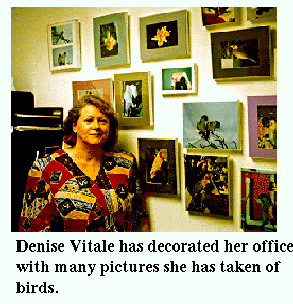 Denise Vitale is one Jefferson Lab employee who is definitely for the birds. She has had two articles and several pictures published in three international bird magazines. She's also the owner of two love birds, six Amadines, and seven Javas. Vitale says being a bird breeder is her way of giving back to the bird community.
Denise Vitale is one Jefferson Lab employee who is definitely for the birds. She has had two articles and several pictures published in three international bird magazines. She's also the owner of two love birds, six Amadines, and seven Javas. Vitale says being a bird breeder is her way of giving back to the bird community.
"There is not very much written about Javas, and a lot of people have not hand fed them. So when I did it, I kept a diary. I thought it was information that would be valuable to other bird breeders," said Vitale.
Recently Vitale had two articles published, one in the June issue of Bird Breeder magazine called, "Diary of a Java Rice Bird Breeder," and the other which will soon be released in Bird Talk magazine,called "A Bird at Work." Pictures of birds taken by Vitale are featured in the article. Vitale also had pictures of her birds published in the April and July issues of Bird Talk magazine. At the request of the magazines, Vitale will continue to submit pictures of her birds as she takes them.
Her large collection of birds has also won awards. "I've placed in the top 10, three times with my British Finches and Javas. My goal was to show birds that I've had the parents of, so I've raised those babies. I accomplished this goal last year," said Vitale.
When Vitale started at Jefferson Lab, four years ago, she worked as secretarial support for the Accelerator Division. Vitale now assists the Division Operations Manager, creating and maintaining numerous databases for the division, and serving as a recorder for the Suggestion Committee, Technical Stockroom Quality Improvement Team, and the Technical Education Enhancement Team.
"What I'm doing now is a bigger challenge," said Vitale. "I feel that being a recorder on the committees working with other divisions, helped me to get a broader perspective of the lab, and I feel like I'm contributing more to the lab as a whole."
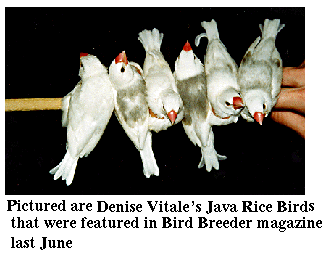 Although Vitale has no plans of becoming a professional bird photographer, she is extremely pleased with the response she has received from her articles and pictures.
Although Vitale has no plans of becoming a professional bird photographer, she is extremely pleased with the response she has received from her articles and pictures.
"Lot's of times when people here find out that I know a little about birds they will come to me with questions or ask me if I have an article or something on a specific type of bird," said Vitale.
For Vitale, writing about birds is a second hobby that came about unexpectedly. "I didn't expect all this to come from it, so it's really nice," said Vitale. "I never planned on breeding either, I just wanted a bird to look at and listen to. The birds made the rest happen."
Camille White, Director's Office Intern
"REAL WORLD" LEARNING
Summer students gain valuable insight
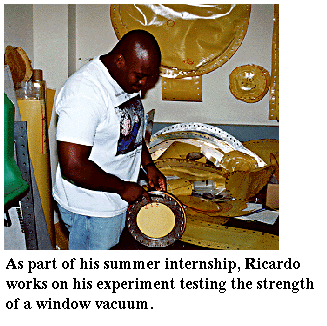 Twenty-two year old Ricardo Walker stares at the thin, laminated mylar and kevlar window as it bubbles - stretching and pulling as water presses in from behind. The Virginia Union University senior wants to see how much pressure the window can take before it bursts. The project is part of his participation in COUPR, a Jefferson Lab summer program for promising undergraduate physics students. Walker's experiment, "Vacuum Window Material Testing," helps ensure that the Laboratory's accelerator beam will safely pass through the windows of Hall C's High Momentum Spectrometer (HMS) and the Short-Orbit Spectrometer. The large HMS vacuum window must hold nine tons of atmospheric pressure when operational, and yet it is only 0.015 of an inch thick. "The window has to be thin enough for the beam to pass through and strong enough to hold vacuum," says Walker.
Twenty-two year old Ricardo Walker stares at the thin, laminated mylar and kevlar window as it bubbles - stretching and pulling as water presses in from behind. The Virginia Union University senior wants to see how much pressure the window can take before it bursts. The project is part of his participation in COUPR, a Jefferson Lab summer program for promising undergraduate physics students. Walker's experiment, "Vacuum Window Material Testing," helps ensure that the Laboratory's accelerator beam will safely pass through the windows of Hall C's High Momentum Spectrometer (HMS) and the Short-Orbit Spectrometer. The large HMS vacuum window must hold nine tons of atmospheric pressure when operational, and yet it is only 0.015 of an inch thick. "The window has to be thin enough for the beam to pass through and strong enough to hold vacuum," says Walker.
"Splash!" The window bursts open with water erupting to the floor. Walker analyzes the results and repeats the process 20 times before reporting his findings to his mentor, a Hall C physicist.
Walker is one of several new faces on the Jefferson Lab campus this summer. In June, 32 undergraduate and graduate physics students from 18 colleges across the country and five world-wide, participated in at least one of three annual summer programs. Walker is one of six students in COUPR, which stands for CEBAF Outstanding Undergraduate Physics Researchship. The program, now in its second year, offers promising physics students real-world experience in a laboratory setting - an opportunity usually reserved for graduate students.
Other summer students attend the laboratory's graduate programs - the 11th Annual Hampton University Graduate Studies (HUGS) and the SURA/Jefferson Lab Graduate Fellowship program. HUGS is a three-week school where graduate students attend daily lectures, interact with leading experimental and theoretical physicists, and publish a scientific paper in the HUGS at Jefferson Lab Proceedings.
"HUGS gives you a lot of ideas in preparing your Ph.D. thesis because of the different lecture topics," said Ho Meoyng Choi. One of last year's HUGS lectures, "Light-Cone Quantum Chromodynamics," is the subject of Choi's fellowship and Ph.D. thesis research. Choi's participation in HUGS last year resulted in his acceptance as a graduate research assistant in the Theory Group.
Fellows from SURA member institutions can conduct research at their home institutions to enhance their coursework, or like Choi, receive summer positions at Jefferson Lab. The aim of the SURA/Jefferson Lab Fellowship program is to give outstanding students the opportunity to strengthen their research capabilities and further assist SURA member institutions in expanding graduate training in nuclear physics, accelerator physics, and related fields.
"The purpose of our summer programs is to introduce young people to the exciting science at Jefferson Lab," says Dr. Nathan Isgur, Director of University Relations. "The expectation is that some of the brightest minds will pursue careers that will lead them to a job here or to a university research position where they use our facilities."
Tarsha Leherr, Director's Office Administrator
EXPLORING THE WORLD OF MAGNETS
Student travels to Germany to research magnetic monopoles
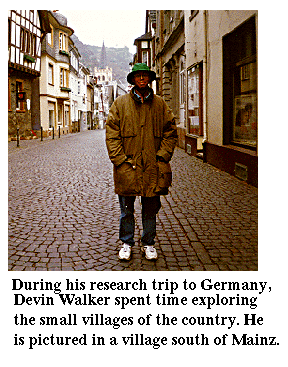 While many of Jefferson Lab's employees have traveled overseas to work at international laboratories, the opportunity is usually not available to the most scholastically apt students at the Laboratory. However, for one Jefferson Lab student that opportunity presented itself last March.
While many of Jefferson Lab's employees have traveled overseas to work at international laboratories, the opportunity is usually not available to the most scholastically apt students at the Laboratory. However, for one Jefferson Lab student that opportunity presented itself last March.
Devin Walker, a junior physics major at Hampton University (HU) and a student researcher in the Lab's Theory Group, traveled to Guttenberg University in Mainz, Germany, to conduct groundbreaking research on magnetic monopoles.
For two weeks, Walker lived and worked at the University's Institute for Nuclear Physics. With help from Warren Buck, Walker's advisor and a researcher in Jefferson Lab's Theory Group, Walker continued work on a theory that, with experimental measure, would place limits on the existence of a magnetic monopole.
He is faced with a difficult task since all magnets occur in pairs, with a north pole and a south pole. When a magnet is cut, that north and south pole still exist, no matter how small the magnet is. By placing a magnet in the hydrogen atom, the resulting energy level shifts of the atom will determine the existence of the magnetic monopole. "It's a fun experiment to look at," says Walker. "People are very interested in it because the magnetic monopoles existence can prove other theories." Walker's trip was funded by HU's Nuclear High Energy Physics Center of Excellence. Without this opportunity, he would not have been able to travel to Mainz, and a valuable part of his research would have been affected, says Walker.
"I was at a point in my research where I had been struggling for three or four months. I went to Germany to conduct research and work on a computer program that analyzes the hydrogen atom, a central part of my theory." Unfortunately, two weeks was not enough time for Walker to accomplish all that he needed to, and he never got the chance to work with the computer program. "I was so busy with other aspects of my research that I never got the chance to use it," says Walker.
With this experience, Buck says that Walker will have a great advantage over other students when he progresses to the graduate- and doctoral-levels of his education. "This trip gave him the ability to set up a working collaboration with physicists from a different country, and it gets him working on an interesting problem that, if solved, will be dramatic,"says Buck.
Buck adds that this is the best time for Walker to start a research project of this magnitude. "I wouldn't recommend this problem to a graduate student because he may not be able to solve it due to time constraints," says Buck. "As an undergraduate, Devin is learning a lot of techniques and a lot of physics that he can use in many other problems."
Walker has only positive things to say about his experiences in Germany. "The people at Guttenberg University are the best in their field," says Walker. "This trip will be something that will benefit me the rest of my career in the world of physics."
Rebecca James, Directors's Office Intern
USER FRIENDLY
Liaison staff serve the Lab's many users
Walking down the hall of the second floor A wing in CEBAF Center can be a cultural experience. At any given time, groups of men and women from France, England, and Armenia, crowd into room A204 asking about physics proposals, training, room allocation, housing, computer availability and directions to a great hamburger. Answering the questions are the staff of Jefferson Lab's User Liaison Office (ULO).
The ULO provides numerous services to the hundreds of users who visit Jefferson Lab. Upon arrival at Jefferson Lab, Users are instructed to go to Room A204 in CEBAF Center. Once there, they can be entered into the Laboratory's Central Information System (CIS) giving them access to the site during normal and after-work hours. They can get information on physics proposals and take the required Environmental, Health & Safety proficiency exams to gain access to the accelerator site. They can also obtain a Jefferson Lab identification badge, EH&S training study guides and office space. The ULO can even enroll users in a visitor's health insurance program.
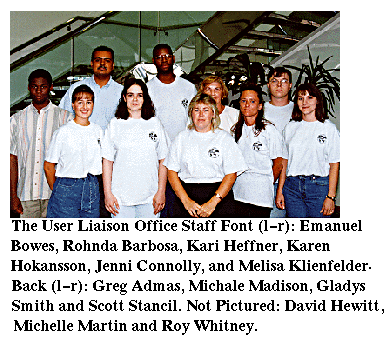 "The people at the User Liaison Office have done everything from investigating taking over my J-1 visa sponsorship from MIT and checking into my eligibility to participate in the Jefferson Lab Visitor's Health Insurance Program, to providing a rather useful checklist for helping me get settled at the laboratory," says Kevin Fissum, a Canadian citizen and postdoctoral fellow at MIT who is doing research at Jefferson Lab. Providing a central location for users to obtain any laboratory-related information, ULO provides for interesting work, says Rhonda Barbosa, a ULO student intern. Barbosa says she enjoys the variety of work she experiences in the office. "Working in the User Liaison office gives me the opportunity to encounter something new and exciting everyday. The staff is great, and we really work hard to provide the users with all the information they need. I also get to meet a lot of interesting people from all over the world," says Barbosa.
"The people at the User Liaison Office have done everything from investigating taking over my J-1 visa sponsorship from MIT and checking into my eligibility to participate in the Jefferson Lab Visitor's Health Insurance Program, to providing a rather useful checklist for helping me get settled at the laboratory," says Kevin Fissum, a Canadian citizen and postdoctoral fellow at MIT who is doing research at Jefferson Lab. Providing a central location for users to obtain any laboratory-related information, ULO provides for interesting work, says Rhonda Barbosa, a ULO student intern. Barbosa says she enjoys the variety of work she experiences in the office. "Working in the User Liaison office gives me the opportunity to encounter something new and exciting everyday. The staff is great, and we really work hard to provide the users with all the information they need. I also get to meet a lot of interesting people from all over the world," says Barbosa.
In addition to servicing new users, the ULO acts as the storehouse for the 164 experimental proposals submitted to Jefferson Lab, and the staff works closely with the User Liaison, Roy Whitney. Whitney facilitates Lab interaction with the users. The office also plays an important role in both the Technical Advisory Committee (TAC) and the Program Advisory Committee (PAC), the two experimental proposal reviewing committees at Jefferson Lab. Copies of PAC reports and an enormous amount of other Jefferson Lab related information have been made available on the World Wide Web through the ULO. Additionally, the office was responsible for compiling 674 proposed talks for the International Conference on Particles and Nuclei (PANIC) held last May at the College of William & Mary.
In fact, the ULO manages Jefferson Lab's home page on the Web. The Web is used as a tool to communicate with the Users Group and other guests. Karen Hokansson, Jefferson Lab's WebMaster and ULO manager says, "With the advent of the Internet and the World Wide Web, people want and need information in real time. By creating and maintaining a resourceful Web site, we are better able to serve our customers."
The Jefferson Lab home page provides users and other guests with information about the laboratory's science education program, meetings, conferences, special events, technology transfer projects and the physics program. Users can also access information about the Hampton Roads area, including weather and directions to local restaurants. In the future, the ULO plans to use the Web for EH&S proficiency testing.
The many services that the ULO provide are essential to the successful operation of Jefferson Lab because of the large number of users who conduct experiments here, says Hokansson. She adds that the User Liaison Office is doing their best to help make Jefferson Lab a world-class facility. "The ULO's first priority is to continually achieve high levels of customer service," says Hokansson. "This focus will provide the Users with an environment that supports the successful running of their experiments and Jefferson Lab's physics program."
Carl Bennett, Director's Office Administration and
Rebeca James, Directirs's Office Intern
ASSOCIATE DIRECTOR ACCEPTS POSITION AT OSTP
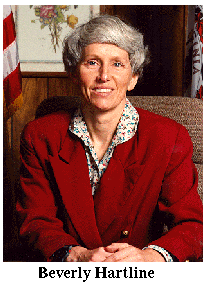 Associate Director and Project Manager, Beverly Hartline, has been selected for a one-year appointment as the Assistant Director of Physical Sciences and Engineering in the U.S. Office of Science and Technology (OSTP) - the office responsible for assisting the U.S. President in the development of national science and technology policy.
Associate Director and Project Manager, Beverly Hartline, has been selected for a one-year appointment as the Assistant Director of Physical Sciences and Engineering in the U.S. Office of Science and Technology (OSTP) - the office responsible for assisting the U.S. President in the development of national science and technology policy.
Hartline will assist the office in their analysis, development, advocacy and implementation of Presidential policy on various science and technology issues, particularly those related to the physical sciences and engineering.
An employee since 1985, Hartline has been responsible for project management of the construction phase of Jefferson Lab since 1989. In 1990, she assumed responsibility for the Lab's pre-college science and math education programs.
Plans to consolidate the Office of Project Management, including its education program, into the Director's Office are underway and will fit with Hartline's plans to begin her new OSTP role in the middle of September.
PRELIMINARY COMMUNICATION SURVEY RESULTS RELEASED
The preliminary results of a survey conducted by the Jefferson Lab Internal Communications Team (ICT) were recently released and suggest the need for improvement of communications at the lab.
The survey results list meetings and electronic media sources as the highest ranked effective communication practices at the lab. Types of information important to respondents include big picture issues, safety issues, personnel and administrative issues, and professional needs (such as technical information and training). Major barriers to good communication listed by respondents include unwillingness to share information, stratification, and apathy. Most agreed that to improve communication at the lab, all must commit to doing so.
The preliminary results are available on the Jefferson Lab home page, while the complete results will be available August 23. Those who have not completed a survey may retrieve a hard copy from an ICT member: Maureen Davis, Joe Goodson, Bill Gunning, Karen Hokansson, Deborah Hyman, Bill Merz, Merle Rivas, Rok Ursic, and Eric Woodworth.
JEFFERSON LAB PRIMER
Adjusting to a new laboratory name has not come without difficulties. Is it TJNAF, Jefferson Lab or Thomas Jefferson National Accelerator Facility? Having three names to deal with has been confusing, but hopefully this primer will make it easier for everyone. The following is the recommended use:
Refer to the entire laboratory with all of its inclusive parts as the Thomas Jefferson National Accelerator Facility for the first use and Jefferson Lab thereafter. For example: The Thomas Jefferson National Accelerator Facility (Jefferson Lab) is a nuclear physics research laboratory. Jefferson Lab's operating budget is approximately $70 million per year.
Refer to the accelerator and three experimental halls by using Continuous Electron Beam Accelerator Facility for the first use and CEBAF thereafter. Refer to the accelerator alone as the Continuous Electron Beam Accelerator and CEBA for short. For example: Construction on the Continuous Electron Beam Accelerator Facility began in 1987. CEBAF was completed on cost and on schedule. The Continuous Electron Beam Accelerator's (CEBA) racetrack-shaped tunnel is 7/8-mile in diameter. CEBA consists of two accelerating sections housed in the straight sections of the tunnel.
HEALTH VIDEOS AVAILABLE FOR CHECK-OUT
Have you seen C. Everett Koop on television recently, promoting a new Time/Life series of health-related videos? Jefferson Lab has purchased a number of these videos for the benefit of the staff. They are available in Medical Services for a one-week check-out.
If, after viewing a tape, you have questions and would like an appointment with Jefferson Lab's physician, please call Medical Services at X7539 to schedule a time for a confidential conference. Please keep in mind that you should see your personal physician promptly for non-work-related health problems.
Titles now (or soon to be) available:
- Alcoholism
- Insomnia
- Coronary Heart Disease
- Stroke
- Prostate Cancer
- Breast Lumps
- Back Pain (Lower Back)
- Depression
- Breast Cancer
- High Blood Pressure
- Overweight & Obesity
- Prostate Disorders
- Colon and Colorectal Cancer
- Stress & Anxiety
There are also Time/Life science education videos available in the Jefferson Lab library. For more information on the following videos, call X7524.
- The Science Almanac for Kids
- Science Starter
- Structure of Matter
- Simple Experiments
Briefly...
JOIN US AT THE STATE FAIR
Come help children and adults explore the wonders of science by serving as a volunteer at Jefferson Lab's State Fair of Virginia exhibit in Richmond, Sept. 26 thru Oct. 6.
At the exhibit, visitors will explore Jefferson Lab via the internet, discover the physics of everyday activities via interactive displays, and witness the ever popular cryogenics show. Volunteers are needed to monitor the exhibit and to interact with the public on behalf of Jefferson Lab. Participants will be eligible to receive mileage and per diem. Interested persons should call Deborah Hyman X-4852 or Donna Lewis at X-7425.
OPERATIONS WORKSHOP A SUCCESS
The inaugural Accelerator Operations Workshop, hosted by Jefferson Lab in late June, may have started something. Greeted by an enthusiastic response from 65 attendees from 21 labs, the workshop will make an encore performance at a yet-to-be-determined site in the summer of 1998.
The event, which was organized by workshop chairman Ron Lauze, lasted four days and provided a forum for the exchange of ideas for Operations professionals. Attendees were kept busy by a full schedule of speakers, addressing a wide variety of topics, such as operator training, accelerator maintenance techniques, control software, and even the effects of sleep deprivation. The presentations were followed by lively roundtable discussions, which permitted the free flow of ideas and the exchange of information. The workshop wrapped up with a tour of Jefferson Lab, including the Machine Control Center, Hall C, and the accelerator tunnel.
FROM LABS TO LIBRARIES
New librarian is no stranger to science
Pick a language. Chances are Nevenka Zdravkovska, Jefferson Lab's newest librarian, will be able to speak it fluently. Zdravkovska has mastered Macedonian, English, French, Croatian, Serbian, and Bulgarian. While these skills are certainly beneficial to an international facility such as Jefferson Lab, Zdravkovska also has other key credentials. She has a Bachelor's of Science degree in Physics from Cyril and Mothodius University, located in her homeland of Skopje, Macedonia, and a Master's of Library Science degree from Texas Woman's University.
"I was interested in Physics while I was growing up. My sister majored in Mathematics, and my brother majored in Chemistry, so I've always been around science," said Zdravkovska.
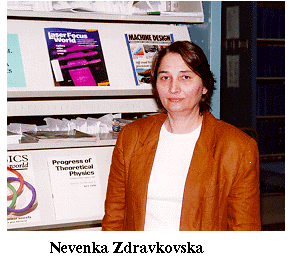 In the beginning of her career, Zdravkovska worked as a meteorologist in a program that tracked hail storms and prevented the hail from falling by emitting silver iodine into the clouds.
In the beginning of her career, Zdravkovska worked as a meteorologist in a program that tracked hail storms and prevented the hail from falling by emitting silver iodine into the clouds.
Zdravkovska says that, although she enjoyed the work, the hours required by this program did not leave her enough time to spend with her family. So, she left her meteorology position and went into library science.
"After I went into library science, I didn't specialize in any particular aspect of science and just knowing general Physics wasn't enough. So when I tried to return to Physics there was a gap of many years and I decided that the library was the best thing for me. And then, I never looked back," said Zdravkovska.
Zdravkovska has a vast knowledge of on-line services which, she says will be valuable for the growth of Jefferson Lab's library. She also said she is looking forward to being able to use her experience to provide services to Lab employees.
Zdravkovska says she finds the atmosphere and the attitudes of employees at Jefferson Lab very nice, and that she has wanted to work here for some time. "I read about the job opening in the newspaper, but even before I read about it I was hoping that an opening would come along and I would get a job here," said Zdravkovska.
Before Jefferson Lab, Zdravkovska worked in the Pearl Bailey Library in Newport News. Prior to that, she spent 15 years at the Macedonian Academy of Sciences and Arts, where she held several positions, including Senior Librarian, Head Coordinator at the Department of Science, and Associate Secretary General of the Academy.
Zdravkovska commented that although she has left the field of science, she still likes to be in a scientific atmosphere. "I really enjoyed my work in the academy. It is a highly scientific institution, and I enjoy being surrounded by scientists. Here at Jefferson Lab, I can enjoy that feeling once again," said Zdravkovska.
Camille White, Director's Office Intern
HEAD START
Area students invest in future careers
While most children are spending their hot, summer days at the pool, the students of CHROME (Cooperating Hampton Roads Organization for Minorities in Engineering) are busy learning how to further their education and future careers. One of the CHROME coordinators, Benjamin Gunter, says the purpose of the CHROME program is to expose young minorities, who plan to go into mathematics or engineering, to as much of those fields as possible. On July 18, exposure is exactly what the students recieved. Three van loads of students, ages 12 to 14, came to Jefferson Lab to hear several engineers speak about the laboratory and their careers.
The students were greeted by Project Management's Teresa Beatty, the Vice Chair for the CHROME Board of Directors, who explained the fundamental properties of the electron, quark, and gluon, and how they relate to the research done at Jefferson Lab.
Then a panel of Jefferson Lab engineers which included Walter Lacy, Butch Dillon-Townes, Ken Law, Herb Ashlock, and student intern, Dominique Green, answered questions from the students that ranged from how does the beam work and is it dangerous, to how much do the engineers get paid and how long did they have to go to school? By the end of the session the children were able to tell the engineers the difference between a laser beam and electron beam, the type of charge given off by the magnets in the accelerator, and that the beam is about the width of a strand of hair. The panelists also gave some inspirational advice. Among other things, Lacy told the students to, "Stay dedicated to education and to try as many new things as possible, so as not to limit yourselves or your opportunities to excel."
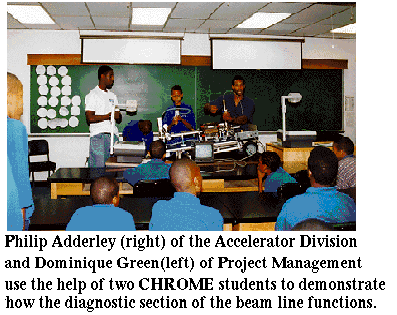 After the question and answer session, Philip Adderley, of the Accelerator Division, showed the group a replica of the diagnostic section of the beam line. He demonstrated, with the help of a few of the CHROME students, how the components work in diagnosing the electron beam's position, size, and focus.
After the question and answer session, Philip Adderley, of the Accelerator Division, showed the group a replica of the diagnostic section of the beam line. He demonstrated, with the help of a few of the CHROME students, how the components work in diagnosing the electron beam's position, size, and focus.
Adderley ended the presentation by telling the children that, "Knowledge is the power. Once you learn something, no one can take it away from you." This is not the first time CHROME, which is sponsored by the National Science Foundation, has come to Jefferson Lab. The relationship between the program and the Lab is one that has a six year history, and according to Beatty, the relationship will continue to grow and prosper.
The students say they are glad they came to the lab. Antonio Abad, a 14-year-old from Great Bridge Middle School North in Chesapeake, said, "I thought it was great. I learned a lot. I learned that there are different kinds of beams, and what they use to analyze the beams, and how they watch it." Michael Faulks, a 13-year-old student from Churchland Junior High School, also in Chesapeake, said he learned about being an engineer, and that, "Even if your friends think you're stupid for going to classes over the summer, you shouldn't do what other people tell you to do. You should do what you think is right."
Camille White, Director's Office Intern
CONFLICT OF INTEREST
on occasion, individuals may find themselves in moral and ethical dilemmas in making decisions about involvement in activities that may create or appear to create a conflict with the interests of the Laboratory.
Conflicts occur when outside activities or interests might have the potential to interfere with effective job performance or impair the judgment or ability of individuals to act in the best interests of the Lab. Admittedly, outside business activities such as consulting for others can be of benefit to the employee and to the Lab. However, in all business dealings one must exercise prudent judgment to avoid situations where one's loyalties may be divided or questioned, particularly in situations involving sensitive procurement, intellectual property, personnel decisions, and outside employment activities.
In all business dealings one must be ever mindful to minimize the potential for conflict of interests by conforming to established standards of professional business conduct and integrity. Further, company policy requires the disclosure of any outside business association and annual resubmission of requests to engage in outside business activities. Last December, Hermann Grunder issued a memorandum to all employees that summarized some of the Lab's basic principles with regard to conflict of interests.
As a reminder, they are as follows:
Competing and conflicting professional interests between the individual staff member and the Laboratory will be resolved in favor of the Laboratory.
Preferential treatment resulting or arising from employment must = be avoided; therefore, even when there is not real conflict of interest, the appearance of one must also be avoided.
Any work done for the Department of Energy or DOE contractors is considered "on the clock" and no additional payments may be accepted for such work. Any other work must be done "off the clock."
The Laboratory's resources (equipment, machinery, computers, stationery, clerical help, etc.) may not be used for outside interests. The Administrative Manual can provide answers to questions on the Lab's Conflict of Interest policy and guidelines.
Merle Rivas, Employee Relations Manager
NEW TIME SHEET SYSTEM TO BEGIN
Say good-bye to paper time sheets. Electronic time sheets will soon be the norm for all Jefferson Lab workers, eliminating existing paper forms. The new time sheet is a version of the system in use by the Accelerator Division. The Task Force, made up of Jami Benson, Mark Davis, Maureen Davis, Bill Kozma, Elizabeth Lawson, and Mike Syptak, will expand on the current system by allowing all Jefferson Lab employees to enter their time electronically which will automatically be sent to Payroll.
This new system will significantly reduce the processing time within the divisions, eliminating missing time sheets, permit electronic signatures with automatic routing to supervisors, provide an improved format to check for and correct errors, and allow for automation of Payroll actions/checks.
The system will be implemented in four phases, with the first phase beginning this month. This phase will be for initial testing and evaluation by personnel familiar with the current system. The second phase is estimated to begin in late August as a first exposure to a select cross-section of personnel. The third phase is estimated to begin Sept. 2, when the system will be used by small groups selected from each division. The final phase is estimated to begin Oct. 1 with lab-wide implementation. For more information contact Maureeen Davis at X-7503.
JEFFERSON LAB INSTITUTIONAL PLAN
- Outstanding research on quark structure of matter
- Run simultaneous experiments; Serve user-customers
- Upgrade to 8 GeV by the year 2001
- Advance and apply core competencies synergistically for customers
- 50 million volt cryomodule
- FEL upgrade to ultraviolet light and higher energy
- Source and detector development
- Outreach to universities, public, business community, and K-12 education
- Constituency building for Jefferson Lab and science
- Effective and cost-effective business practices, human resources management/training and EH&S Issues
- Funding for full utilization, site infrastructure and users

